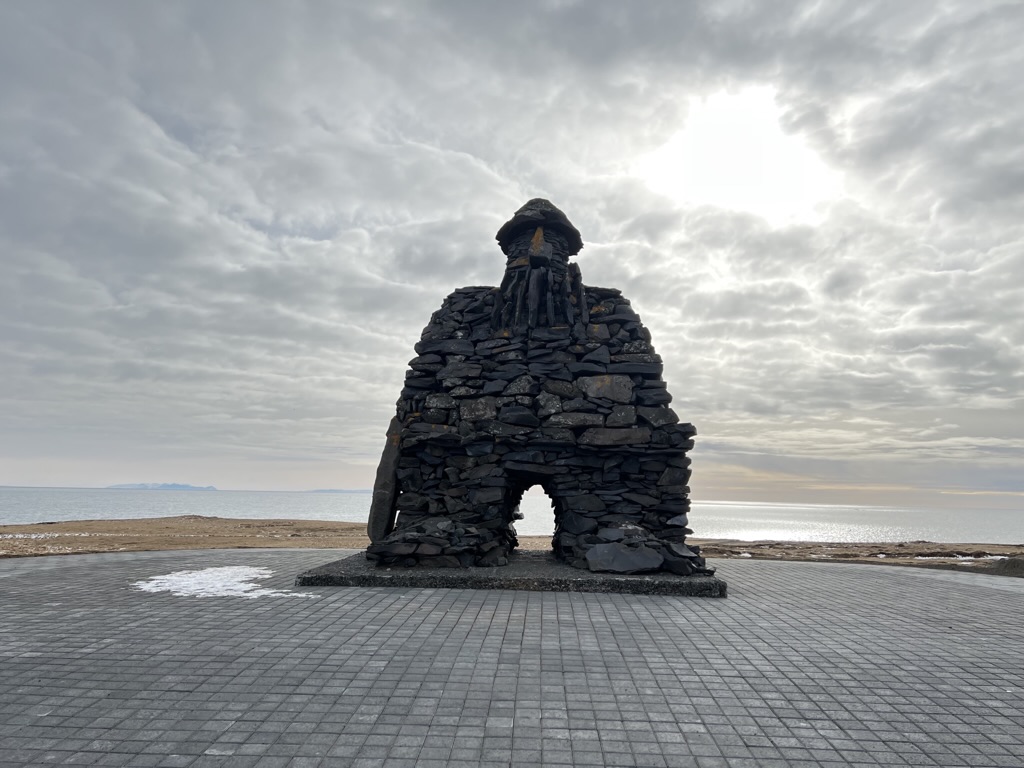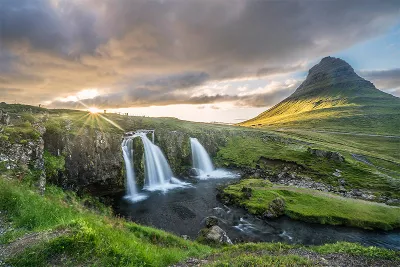Must try Icelandic food
Upon traveling to a new country, exploring gastronomy is a vital part of getting to know its culture and country, Icelandic food is no exception there. Due to the abundance of clear water and air, abundance of fresh fish, free grazing sheep and cows, and literally chemical-free plants, the quality of the Icelandic cuisine is top of its class and its freshness can truly be sensed when consuming the food.
Iceland is especially known for its free-grazing lamb, its abundance of fresh fish and seafood, a dairy product called ‘Skyr’, and the use of local ingredients. As for sweets, licorice in any combination is the most popular candy, so much so that licorice flavor is often added to some popular dishes for a different variation.
Traditionally, before the age of refrigeration, Icelanders like other nations had to turn to other drastic methods to preserve their fish and meat, using methods like smoking, salting, underground cooking, drying, and fermentation in order to make the food keep longer. There are a variety of dishes that derive from the old tradition of preservation, some of which are considered a delicacy others more controversial strange type of food, some of which are only eaten during special occasions.
Iceland is known for its stunning nature and distinct landscape and is often referred to as the Land of Ice and Fire, being located in a hot spot area with an abundance of craters, volcanos, lava fields, and a number of glaciers. Thus, you could say visiting Iceland is not only a feast for the eyes but a banquet for your taste buds as well.
Icelandic Skyr
The popular Icelandic food called Skyr is a healthy Icelandic dairy specialty that is gaining ground around the world and is rooted in Icelandic traditions since the arrival of the Vikings. Although the product resembles yogurt it is technically classified as cheese. Traditionally, skyr only had one flavor and was served with cream and topped with brown sugar. However, today, you can buy a variety of skyr products with different flavors to choose from.
You can eat skyr from the container, but if you go for the traditional unflavored skyr, it may be too sour, so it is advisable to add sugar. Icelanders have consumed skyr on their own at any time of the day for years. However, skyr is also widely used for desserts, including skyr cake (similar to cheesecake) or with chopped biscuits as a base and topped with some berries and cream. Next time you visit an Icelandic restaurant, don’t be surprised to see skyr listed as dessert, as skyr cake or dessert served with vanilla skyr topped with berries and cream or even with a licorice flavor.
How is Skyr made?
Skyr is a thick and creamy dairy product made by separating skim milk from the cream, which is then pasteurized and then live cultures similar to yogurt are added. When the skyr product has thickened enough, it is filtered and different flavors added, including vanilla, fruits, berries, coconut or even licorice, depending on the type of skyr to be produced.
Icelandic Hot Dogs
A must-have dish is ‘pylsa’ a hot dog served at Reykjavik’s Bæjarins Beztu Pylsur, which is renowned for its traditional hot dogs made from a mixture of beef, lamb, and pork. Icelanders typically order ‘eina með öllu’ which literally means, one with everything, which includes a hot dog served in a bread bun with ketchup, sweet brown mustard, deep-fried onions, raw onions, and a remoulade sauce. This hot dog stand in Reykjavik is typically packed with tourists, especially during lunchtime, but locals are frequent visitors as well, especially if they need something quick and easy or after a night out drinking.

Traditional Icelandic bread & pastry
As the Vikings settled and started farming, they significantly impacted the landscape and caused wide-scale erosion and deforestation. Due to grain harvesting difficulties through the centuries, Icelandic settlers didn’t have the luxury of accessing grain that easily. Very little could grow in the barren Icelandic soil except for cabbage, cauliflower and root vegetables like potatoes, carrots, and turnips, but almost no grain.
Iceland never became self-sufficient in grain production, in some places barley would grow but the yield was very limited due to the cold climate. However, after a cold period known as the ‘Little Ice Age’, almost all cultivation of grain came to a stop in Iceland and it wasn’t until the 20th century that cultivation of grain started again, primarily with barley being the main harvest.
Later some oat farming started. Due to the shortage of firewood, ovens were largely unknown. Thus, grain had to be imported and was therefore very expensive and only for the more wealthy. Sugar was introduced into the diet during the 19th century, at a time when ovens became more common and bakeries could be found. Despite grain harvesting difficulties and shortage of equipment for making bread, there are still some traditional bread and pastry signature dishes rooted in tradition.
Flatbread
A traditional bread called ‘Flatkaka’ is a thin unleavened flatbread made of rye and often served with thin slices of smoked lamb, mutton paté, or cheese. This type of flatbread is made by mixing boiled water with flour and then cooking the dough. Historically, Icelandic settlers supplemented rye with moss, as grain was so scarce, and baked them on hot stones or straight over the fire. But, it has since then been replaced with rye flour and iron frying pans.

Rye bread
Another traditional bread is ‘rúgbrauð’ or rye bread which is a thick dark-colored bread with no crust, which is quite sweet to the taste and thick in texture. It is served with butter and can be eaten with mutton paté, smoked lamb (‘hangikjöt’), cheese smoked salmon, or pickled herring. Additionally, it can be paired with ‘plokkfiskur’ an Icelandic signature fish plate, which is a type of fish stew.
Traditionally, there are two ways to make this type of bread. It can either be baked in a pot placed on embers of a dying fire or buried and left to stand overnight, covered in turf or it can be placed in a pot and cooked underground near a hot spring. The second method is called ‘hverabrauð’ or hot spring bread. Today, most Icelanders utilize modern ovens to bake their rye bread but there are still some bakeries and touristic places that rely on traditional methods to get the authentic consistency and flavor.
If you would like something different and have an authentic experience, witnessing ‘hverabrauð’ cooked underground near a hot spring in front of your eyes and then get to taste it, then you can visit Laugarvatn Fontana geothermal baths which are located on the popular Golden Circle route or you could visit Café Loki by church Hallgrímskirkja to taste it.
Kleinur
This type of pastry is similar to a doughnut in texture and can be found throughout the Nordic countries in slight variations. What makes the Icelandic Kleinur different is the unusual aroma of cardamom and nutmeg which is added to the dough. You can find Kleinur in every supermarket packed in plastic bags or at a local bakery. In order to make it the dough is made and special care is needed not to knead it too much, in order to keep the soft texture, then the dough is cut into a special trapezoidal shape using a special tool called ‘kleinujárn’ before it is deep-fried.

Laufabrauð
Laufabrauð or leaf-bread is traditional pastry families make together before Christmas and is typically served with butter and eaten with ‘hangikjöt’ (smoked lamb). This is a very thin flatbread that is carved in distinct and creative patterns, not so unlike paper snowflakes, and then fried.
The first reference to the making of Laufabrauð dates back to the 18th century, during which time access to grain, salt, and sugar was limited, especially during winters. Hence, the trick was to spread the dough as thin as possible to make more portions. Although, at times leaf bread can be cut out so it resembles tree leaves, that is not the reason behind the name, the idea behind the name is its ‘thinness’, that is to say, it is thin as leaves. Check out the video below and see how to make leaf bread yourself.
Icelandic Lamb
Sheep has been rooted in Icelanders history since the arrival of the Vikings who brought their own life stock. It has become a staple in Icelandic diet and its wool has kept Icelanders warm through hard winters. Since then the sheep breed has developed in total isolation, totally unaffected by other breeds, and is therefore sometimes referred to as the ‘settlement breed’.
What makes the Icelandic sheep unique is that every spring they are let out of the barn and allowed to roam freely around the hills of the countryside during the entire summer grazing through the pastures and wilderness and consuming grass, berries, seaweed, and other plants in the pesticide-free wilderness and drink water from glacier rivers. This gives the meat its distinct flavor, which is tender and mild in flavor. Lamb or mutton are an absolute must try Icelandic food!
Despite, the popularity of the Icelandic woolen sweaters, the Icelandic sheep is largely farmed for meat production purposes. There are various dishes that can be found throughout the country and the cooking methods vary, it can be smoked, graved, slow-cooked, broiled, or put on a grill. Below are some of the most famous Icelandic lamb dishes. For a good lamb, we recommend Seafood Grill and Kopar Restaurant.
Icelandic Meat Soup
The traditional Icelandic Meat Soup is a stable in the Icelandic diet, especially during cold winter nights. It is largely made from tougher bits of lamb, which still have bone, and cooked with potatoes, rutabagas, carrots, leek, and various herbs. Some households even boil it with rice.

Smoked Lamb
As has been mentioned before, ‘hangikjöt’ or smoked lamb is a national dish that is traditionally eaten during Christmas and served with potatoes, green beans, red cabbage, leaf bread, and other assortments, or by itself on a piece of bread such as flatbread or rye bread. The name of the dish, hangikjöt literally translates as ‘hung meat’ which is a reference to the old tradition of hanging the meat while smoking it. There are mainly two methods for smoking meat in Iceland, those are by using birch wood (a.k.a. ‘birkireykt’) or dried sheep dung which is mixed with some hey (a.k.a. ‘taðreykt’). Smoked lamb is typically served warm or cold.

Roasted rack of lamb
This is a traditional dish that is roasted in an oven covered with a nice coating of various spices and herbs typically cooked with root vegetables and served with potatoes, green beans, and gravy. Typically this dish can be found in every Icelandic restaurant.
Icelandic Seafood
Back in the day, before refrigerators entered the market, Icelanders used various preservation methods to make their fish and meat keep longer. Traditionally, they smoked, dried, or fermented their meat and fish. Before the 19th century, grain was scarce and needed to be imported from Denmark, thus bread was very expensive and considered a luxury, so instead of consuming bread as was customary in other Nordic countries, Icelanders ate dried fish.
As refrigeration became available, fresh fish became more part of the Icelandic diet and in the 1950s Icelanders ate it almost daily. Today, Icelanders consume fish on average two times a week and over half of the population take ‘Lýsi’, a type of fish oil made of cod that contains omega fatty acids and is said to be very healthy.
Harðfiskur, an Icelandic delicacy made of dried fish
A type of dried fish called ‘harðfiskur’, a healthy snack, stable in the Icelandic diet. It can be purchased at any grocery store and eaten by itself or served with a decent amount of butter. Harðfiskur is most commonly made of cod, but can also be made from haddock or wolfish. After catching the fish, it is cleaned, deboned, hung up, and left to dry. Back in the day, this process was performed outside, near the ocean to take advantage of the sea salt that wind blew through the product but this process could take up to 4-6 weeks. However, luckily today with modern technology, the production process has been shortened down to about 3 days.
Although most tourists hold their noses when they smell the fish, Icelanders find it funny as the smell is no worse than a strong fermented cheese. Icelanders also often give their best friend, the dog this special treat when they are spoiling them, which makes them go bananas. Despite the smell, most people that try this delicacy, are pleasantly surprised and end up buying a pack to bring home.
Langoustine, the Icelandic Lobster
The Icelandic lobster or ‘humar’ is a small type of lobster called langoustine which has a very firm texture, similar to monkfish, and is known for its tasty and tender meat. Traditionally lobster is fried on a pan with garlic and served with lemon, melted butter, and herb garnish but it can also be grilled, baked, or boiled. You find this type of langoustine on the menu in almost every Icelandic restaurant, often served as a dish on itself or as a lobster soup. If you would like to try Icelandic lobster, try Kopar Restaurant or The Fish Market.
Plokkfiskur, a tasty fish stew
This dish which literally translates as ‘plucked fish’ is a type of hearty fish stew that has become stable in the Icelandic diet and was traditionally made of leftover fish, potatoes, flour, onions, butter, milk, and seasoning. However, various ingredients can be added, including chives, curry, and even cheese or, bearnaise sauce. Usually, the fish stew is made with cod, halibut, or haddock and typically served with rye bread. If you would like to try this dish you will find it on the menu of Café Loki by church Hallgrímskirkja.
Fermented Shark
Traditionally, before the refrigerators, people had to turn to drastic measures to preserve their meat and fish, so that they kept longer. Historically the shark was soaked in urine and put underground to ferment, however, today this practice is outdated. Although fermented shark is no longer a frequent thing you see on the dinner table unless there is a tourist in sight, it is mainly eaten during a period called ‘Þorrinn’ typically when a large number of people come together to feast on all kinds of strange food at a celebration called ‘Þorrablót’.
Typically fermented shark is paired with a shot of ‘Brennivín’ an Icelandic liquor also known as black death, which is a clear, strong, and unsweetened type of schnapps that is supposed to help keep the strong aroma flavor of the shark away and make it easier to swallow. If you have the guts to try this Icelandic specialty, you can go to the restaurant Þrír Frakkar at Baldursgata in downtown Reykjavik or visit the Viking Village in Hafnarfjörður where you can have an authentic Viking experience, as the servers are dressed in Viking garments.
Icelandic Ice Cream
Indulging oneself and having an ice cream is a big part of being Icelandic, even when it is freezing cold outside, which is something foreigners find surprising. There are plenty of great ice cream parlors to explore around Reykjavik. For instance, Ísbúð Hubbu, Ísbúðin Laugalæk , and Ísbúð Vesturbæjar where you can get traditional soft ice cream and choose from cream-based one (a.k.a. the new ice cream) or more vanilla-based ice cream (a.k.a. the old ice cream) and a selection of different flavored ice creams.
It is customary to get a soft ice cream and dip it into hard shell chocolate or a different flavor such as licorice or caramel and cover it with small-sized candy. This is referred to as ‘ís með dýfu og kurli’. If you want to get more adventurous, go for ‘Bragðarefur’, which is soft ice cream mixed we 3 types of candy or fruits, which are then mixed together and topped with some candy.

Another popular ice cream parlor is Valdís located at Grandi which offers a variety of sorted ice creams similar to Italian gelato. At Cafe Loki by Hallgrímskirkja, you can also get rye bread Ice cream. You could also visit Sandholt Bakery and try their delicious coconut ice cream. Or you could travel through the popular Golden Circle route and make a stop at Friðheimar tomato farm and try their special tomato ice cream.



